Analysis of Training and Development in Australian Organizations
VerifiedAdded on 2021/04/21
|8
|2001
|120
Report
AI Summary
This report provides an overview of the significance of training and development in the workplace, focusing on Australian organizations. It examines the environmental forces influencing these organizations, such as sustainability, globalization, and technological advancements, and how they impact training strategies. The report highlights the importance of strategic training methods, including in-basket training and e-learning, to address these forces. It identifies attracting and retaining talented employees as a key environmental force. Furthermore, the report emphasizes the need for leadership development skills in designing and managing training programs. The training design process, including assessment, learning environment creation, and evaluation, is also discussed. The report concludes by stressing the need for organizations to invest in leadership development and design training programs based on workplace needs to enhance employee skills and overall organizational performance.
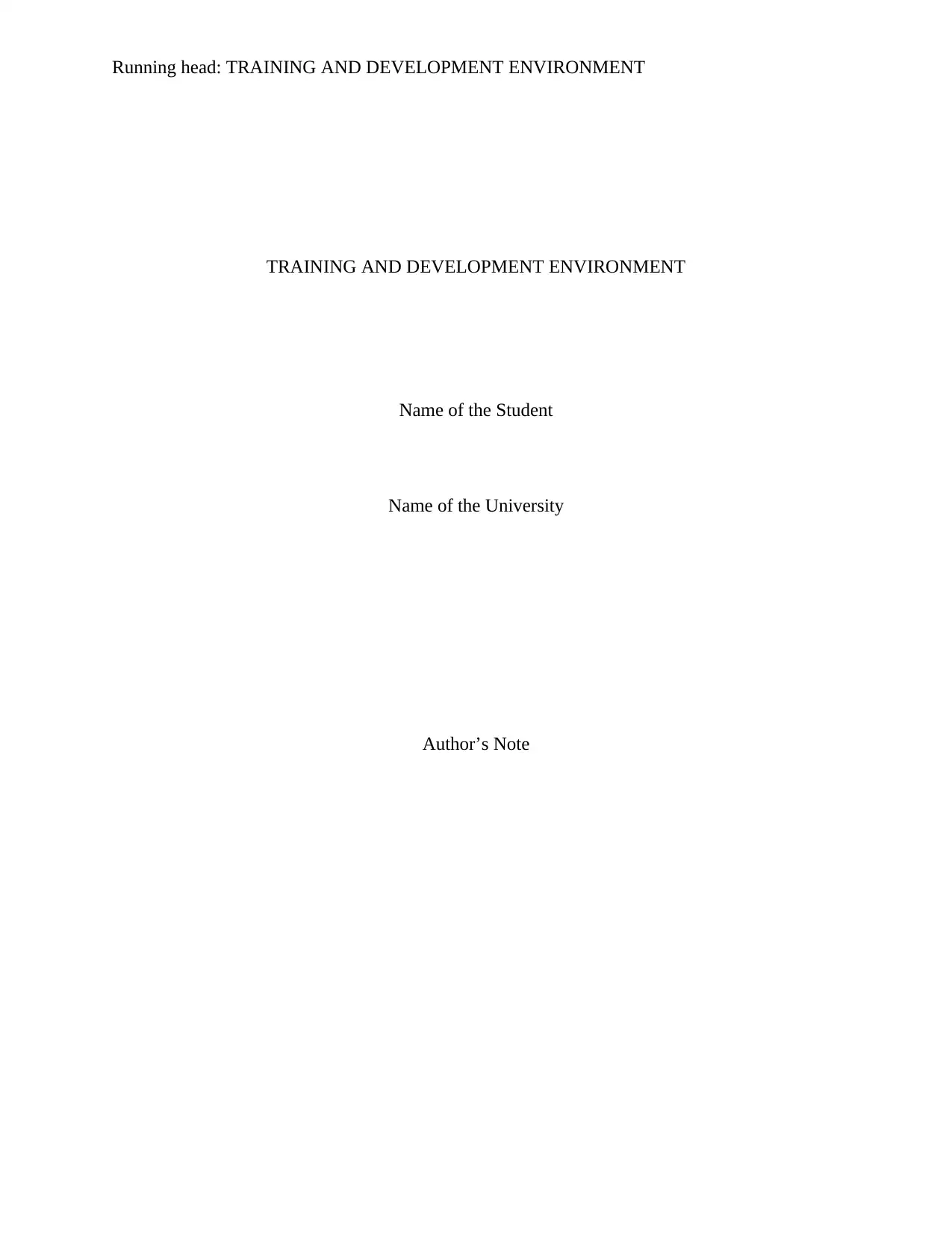
Running head: TRAINING AND DEVELOPMENT ENVIRONMENT
TRAINING AND DEVELOPMENT ENVIRONMENT
Name of the Student
Name of the University
Author’s Note
TRAINING AND DEVELOPMENT ENVIRONMENT
Name of the Student
Name of the University
Author’s Note
Paraphrase This Document
Need a fresh take? Get an instant paraphrase of this document with our AI Paraphraser
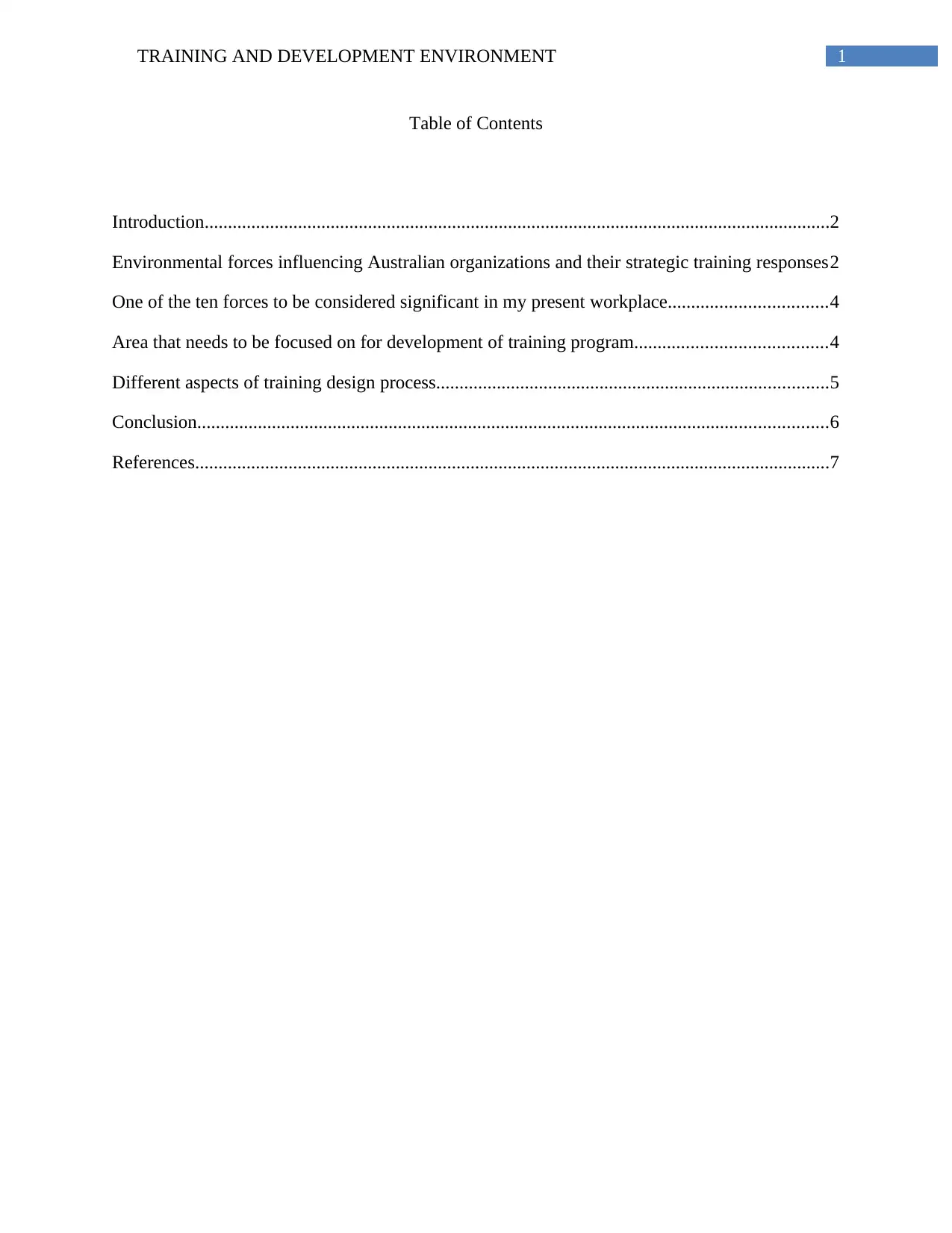
1TRAINING AND DEVELOPMENT ENVIRONMENT
Table of Contents
Introduction......................................................................................................................................2
Environmental forces influencing Australian organizations and their strategic training responses2
One of the ten forces to be considered significant in my present workplace..................................4
Area that needs to be focused on for development of training program.........................................4
Different aspects of training design process....................................................................................5
Conclusion.......................................................................................................................................6
References........................................................................................................................................7
Table of Contents
Introduction......................................................................................................................................2
Environmental forces influencing Australian organizations and their strategic training responses2
One of the ten forces to be considered significant in my present workplace..................................4
Area that needs to be focused on for development of training program.........................................4
Different aspects of training design process....................................................................................5
Conclusion.......................................................................................................................................6
References........................................................................................................................................7
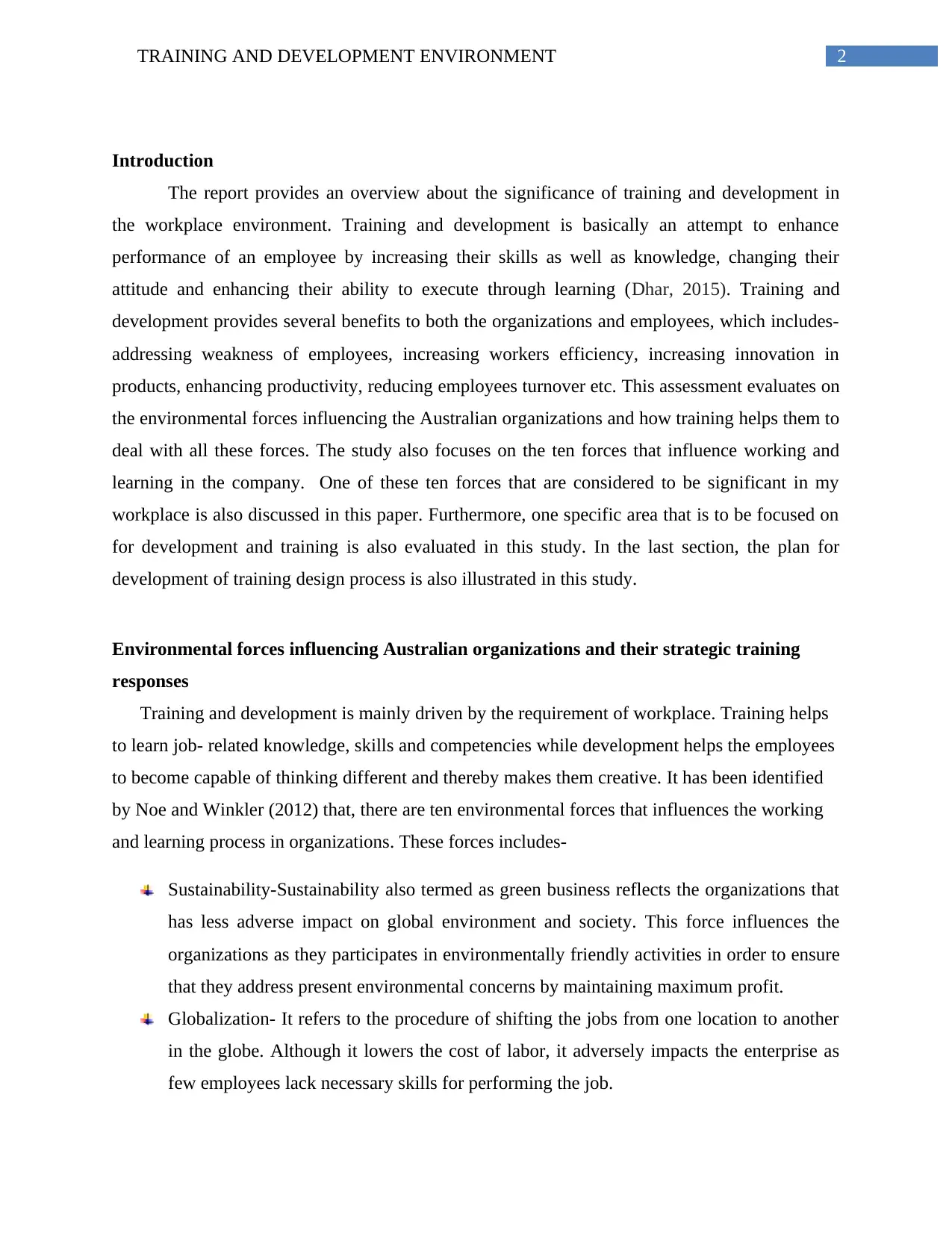
2TRAINING AND DEVELOPMENT ENVIRONMENT
Introduction
The report provides an overview about the significance of training and development in
the workplace environment. Training and development is basically an attempt to enhance
performance of an employee by increasing their skills as well as knowledge, changing their
attitude and enhancing their ability to execute through learning (Dhar, 2015). Training and
development provides several benefits to both the organizations and employees, which includes-
addressing weakness of employees, increasing workers efficiency, increasing innovation in
products, enhancing productivity, reducing employees turnover etc. This assessment evaluates on
the environmental forces influencing the Australian organizations and how training helps them to
deal with all these forces. The study also focuses on the ten forces that influence working and
learning in the company. One of these ten forces that are considered to be significant in my
workplace is also discussed in this paper. Furthermore, one specific area that is to be focused on
for development and training is also evaluated in this study. In the last section, the plan for
development of training design process is also illustrated in this study.
Environmental forces influencing Australian organizations and their strategic training
responses
Training and development is mainly driven by the requirement of workplace. Training helps
to learn job- related knowledge, skills and competencies while development helps the employees
to become capable of thinking different and thereby makes them creative. It has been identified
by Noe and Winkler (2012) that, there are ten environmental forces that influences the working
and learning process in organizations. These forces includes-
Sustainability-Sustainability also termed as green business reflects the organizations that
has less adverse impact on global environment and society. This force influences the
organizations as they participates in environmentally friendly activities in order to ensure
that they address present environmental concerns by maintaining maximum profit.
Globalization- It refers to the procedure of shifting the jobs from one location to another
in the globe. Although it lowers the cost of labor, it adversely impacts the enterprise as
few employees lack necessary skills for performing the job.
Introduction
The report provides an overview about the significance of training and development in
the workplace environment. Training and development is basically an attempt to enhance
performance of an employee by increasing their skills as well as knowledge, changing their
attitude and enhancing their ability to execute through learning (Dhar, 2015). Training and
development provides several benefits to both the organizations and employees, which includes-
addressing weakness of employees, increasing workers efficiency, increasing innovation in
products, enhancing productivity, reducing employees turnover etc. This assessment evaluates on
the environmental forces influencing the Australian organizations and how training helps them to
deal with all these forces. The study also focuses on the ten forces that influence working and
learning in the company. One of these ten forces that are considered to be significant in my
workplace is also discussed in this paper. Furthermore, one specific area that is to be focused on
for development and training is also evaluated in this study. In the last section, the plan for
development of training design process is also illustrated in this study.
Environmental forces influencing Australian organizations and their strategic training
responses
Training and development is mainly driven by the requirement of workplace. Training helps
to learn job- related knowledge, skills and competencies while development helps the employees
to become capable of thinking different and thereby makes them creative. It has been identified
by Noe and Winkler (2012) that, there are ten environmental forces that influences the working
and learning process in organizations. These forces includes-
Sustainability-Sustainability also termed as green business reflects the organizations that
has less adverse impact on global environment and society. This force influences the
organizations as they participates in environmentally friendly activities in order to ensure
that they address present environmental concerns by maintaining maximum profit.
Globalization- It refers to the procedure of shifting the jobs from one location to another
in the globe. Although it lowers the cost of labor, it adversely impacts the enterprise as
few employees lack necessary skills for performing the job.
⊘ This is a preview!⊘
Do you want full access?
Subscribe today to unlock all pages.

Trusted by 1+ million students worldwide
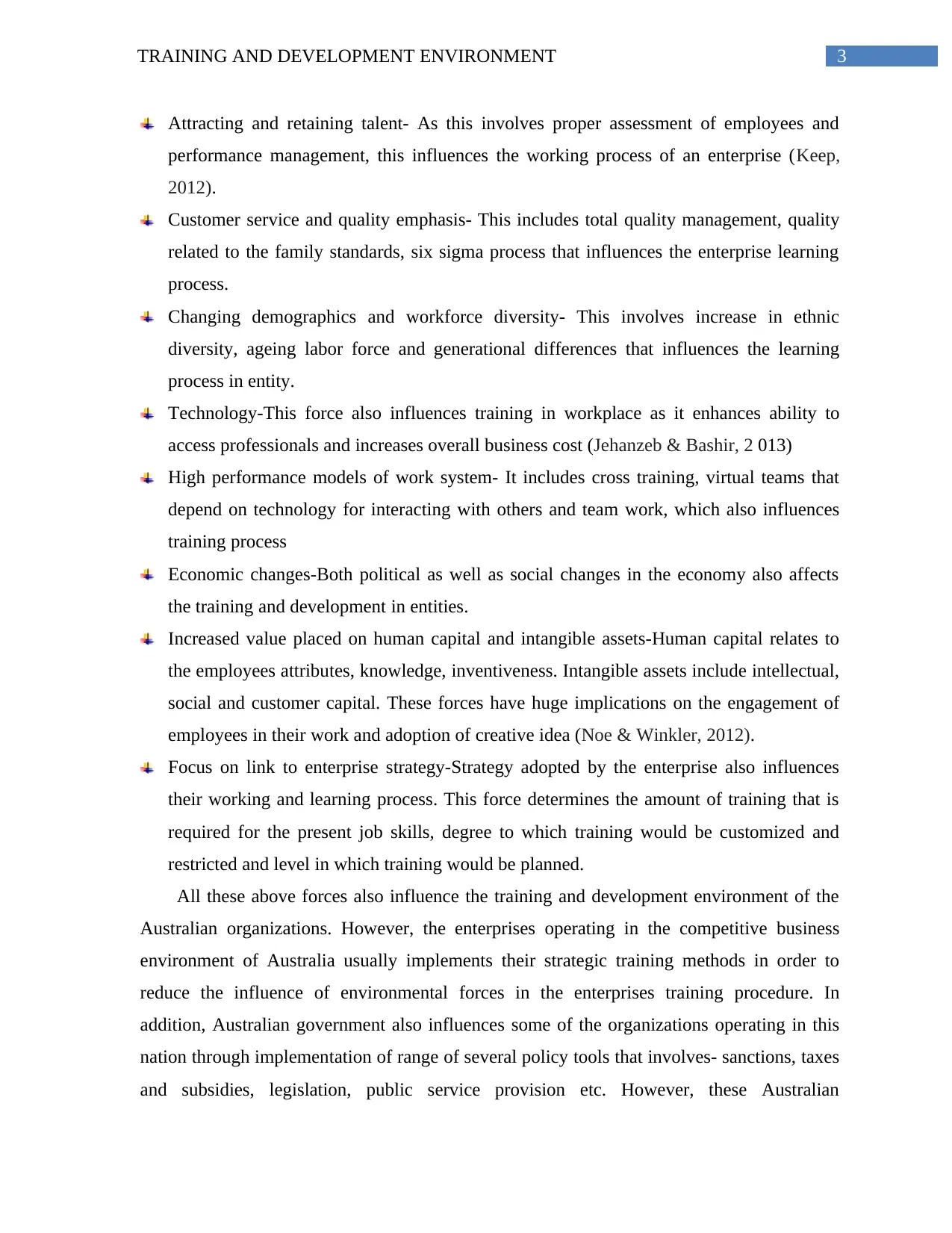
3TRAINING AND DEVELOPMENT ENVIRONMENT
Attracting and retaining talent- As this involves proper assessment of employees and
performance management, this influences the working process of an enterprise (Keep,
2012).
Customer service and quality emphasis- This includes total quality management, quality
related to the family standards, six sigma process that influences the enterprise learning
process.
Changing demographics and workforce diversity- This involves increase in ethnic
diversity, ageing labor force and generational differences that influences the learning
process in entity.
Technology-This force also influences training in workplace as it enhances ability to
access professionals and increases overall business cost (Jehanzeb & Bashir, 2 013)
High performance models of work system- It includes cross training, virtual teams that
depend on technology for interacting with others and team work, which also influences
training process
Economic changes-Both political as well as social changes in the economy also affects
the training and development in entities.
Increased value placed on human capital and intangible assets-Human capital relates to
the employees attributes, knowledge, inventiveness. Intangible assets include intellectual,
social and customer capital. These forces have huge implications on the engagement of
employees in their work and adoption of creative idea (Noe & Winkler, 2012).
Focus on link to enterprise strategy-Strategy adopted by the enterprise also influences
their working and learning process. This force determines the amount of training that is
required for the present job skills, degree to which training would be customized and
restricted and level in which training would be planned.
All these above forces also influence the training and development environment of the
Australian organizations. However, the enterprises operating in the competitive business
environment of Australia usually implements their strategic training methods in order to
reduce the influence of environmental forces in the enterprises training procedure. In
addition, Australian government also influences some of the organizations operating in this
nation through implementation of range of several policy tools that involves- sanctions, taxes
and subsidies, legislation, public service provision etc. However, these Australian
Attracting and retaining talent- As this involves proper assessment of employees and
performance management, this influences the working process of an enterprise (Keep,
2012).
Customer service and quality emphasis- This includes total quality management, quality
related to the family standards, six sigma process that influences the enterprise learning
process.
Changing demographics and workforce diversity- This involves increase in ethnic
diversity, ageing labor force and generational differences that influences the learning
process in entity.
Technology-This force also influences training in workplace as it enhances ability to
access professionals and increases overall business cost (Jehanzeb & Bashir, 2 013)
High performance models of work system- It includes cross training, virtual teams that
depend on technology for interacting with others and team work, which also influences
training process
Economic changes-Both political as well as social changes in the economy also affects
the training and development in entities.
Increased value placed on human capital and intangible assets-Human capital relates to
the employees attributes, knowledge, inventiveness. Intangible assets include intellectual,
social and customer capital. These forces have huge implications on the engagement of
employees in their work and adoption of creative idea (Noe & Winkler, 2012).
Focus on link to enterprise strategy-Strategy adopted by the enterprise also influences
their working and learning process. This force determines the amount of training that is
required for the present job skills, degree to which training would be customized and
restricted and level in which training would be planned.
All these above forces also influence the training and development environment of the
Australian organizations. However, the enterprises operating in the competitive business
environment of Australia usually implements their strategic training methods in order to
reduce the influence of environmental forces in the enterprises training procedure. In
addition, Australian government also influences some of the organizations operating in this
nation through implementation of range of several policy tools that involves- sanctions, taxes
and subsidies, legislation, public service provision etc. However, these Australian
Paraphrase This Document
Need a fresh take? Get an instant paraphrase of this document with our AI Paraphraser
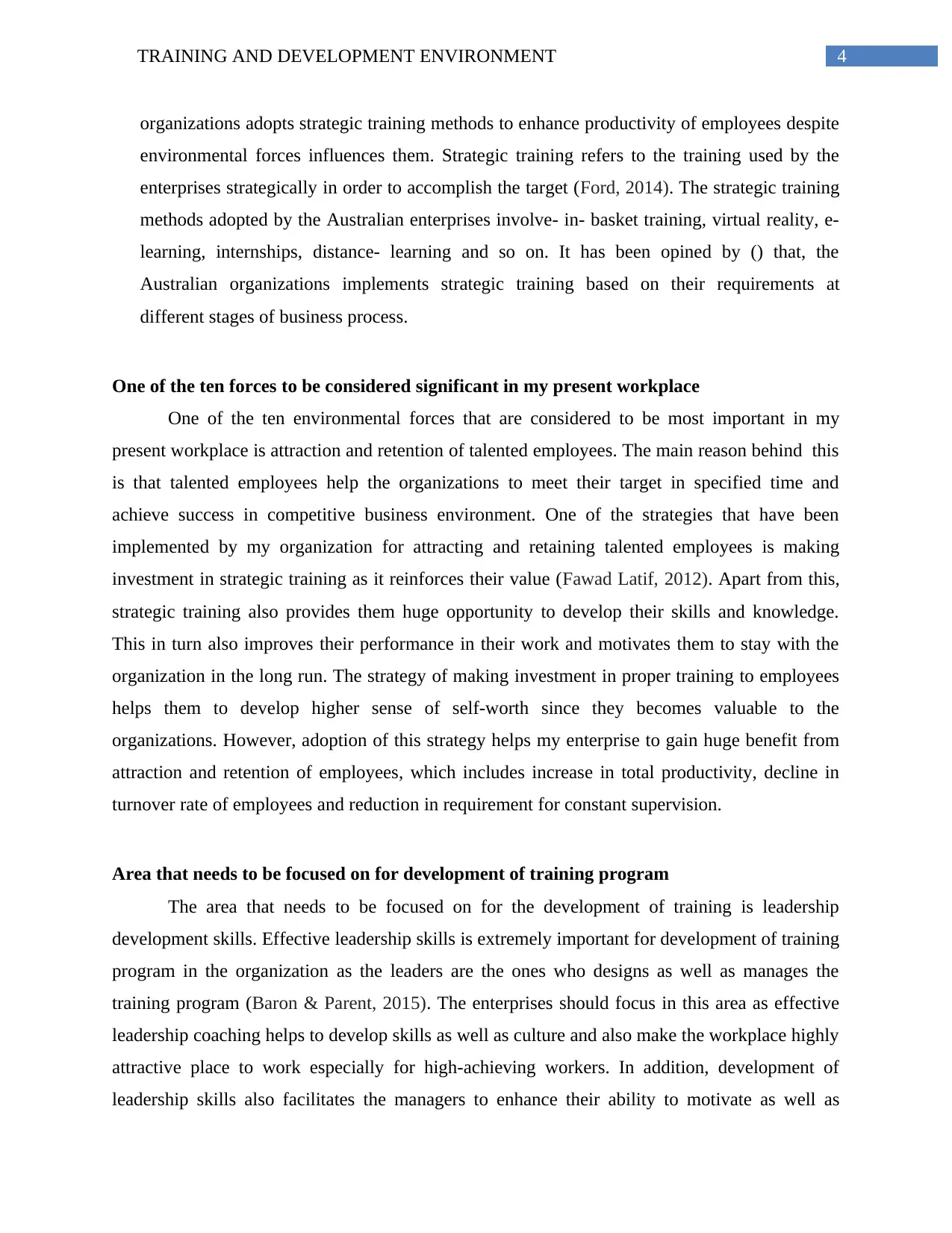
4TRAINING AND DEVELOPMENT ENVIRONMENT
organizations adopts strategic training methods to enhance productivity of employees despite
environmental forces influences them. Strategic training refers to the training used by the
enterprises strategically in order to accomplish the target (Ford, 2014). The strategic training
methods adopted by the Australian enterprises involve- in- basket training, virtual reality, e-
learning, internships, distance- learning and so on. It has been opined by () that, the
Australian organizations implements strategic training based on their requirements at
different stages of business process.
One of the ten forces to be considered significant in my present workplace
One of the ten environmental forces that are considered to be most important in my
present workplace is attraction and retention of talented employees. The main reason behind this
is that talented employees help the organizations to meet their target in specified time and
achieve success in competitive business environment. One of the strategies that have been
implemented by my organization for attracting and retaining talented employees is making
investment in strategic training as it reinforces their value (Fawad Latif, 2012). Apart from this,
strategic training also provides them huge opportunity to develop their skills and knowledge.
This in turn also improves their performance in their work and motivates them to stay with the
organization in the long run. The strategy of making investment in proper training to employees
helps them to develop higher sense of self-worth since they becomes valuable to the
organizations. However, adoption of this strategy helps my enterprise to gain huge benefit from
attraction and retention of employees, which includes increase in total productivity, decline in
turnover rate of employees and reduction in requirement for constant supervision.
Area that needs to be focused on for development of training program
The area that needs to be focused on for the development of training is leadership
development skills. Effective leadership skills is extremely important for development of training
program in the organization as the leaders are the ones who designs as well as manages the
training program (Baron & Parent, 2015). The enterprises should focus in this area as effective
leadership coaching helps to develop skills as well as culture and also make the workplace highly
attractive place to work especially for high-achieving workers. In addition, development of
leadership skills also facilitates the managers to enhance their ability to motivate as well as
organizations adopts strategic training methods to enhance productivity of employees despite
environmental forces influences them. Strategic training refers to the training used by the
enterprises strategically in order to accomplish the target (Ford, 2014). The strategic training
methods adopted by the Australian enterprises involve- in- basket training, virtual reality, e-
learning, internships, distance- learning and so on. It has been opined by () that, the
Australian organizations implements strategic training based on their requirements at
different stages of business process.
One of the ten forces to be considered significant in my present workplace
One of the ten environmental forces that are considered to be most important in my
present workplace is attraction and retention of talented employees. The main reason behind this
is that talented employees help the organizations to meet their target in specified time and
achieve success in competitive business environment. One of the strategies that have been
implemented by my organization for attracting and retaining talented employees is making
investment in strategic training as it reinforces their value (Fawad Latif, 2012). Apart from this,
strategic training also provides them huge opportunity to develop their skills and knowledge.
This in turn also improves their performance in their work and motivates them to stay with the
organization in the long run. The strategy of making investment in proper training to employees
helps them to develop higher sense of self-worth since they becomes valuable to the
organizations. However, adoption of this strategy helps my enterprise to gain huge benefit from
attraction and retention of employees, which includes increase in total productivity, decline in
turnover rate of employees and reduction in requirement for constant supervision.
Area that needs to be focused on for development of training program
The area that needs to be focused on for the development of training is leadership
development skills. Effective leadership skills is extremely important for development of training
program in the organization as the leaders are the ones who designs as well as manages the
training program (Baron & Parent, 2015). The enterprises should focus in this area as effective
leadership coaching helps to develop skills as well as culture and also make the workplace highly
attractive place to work especially for high-achieving workers. In addition, development of
leadership skills also facilitates the managers to enhance their ability to motivate as well as
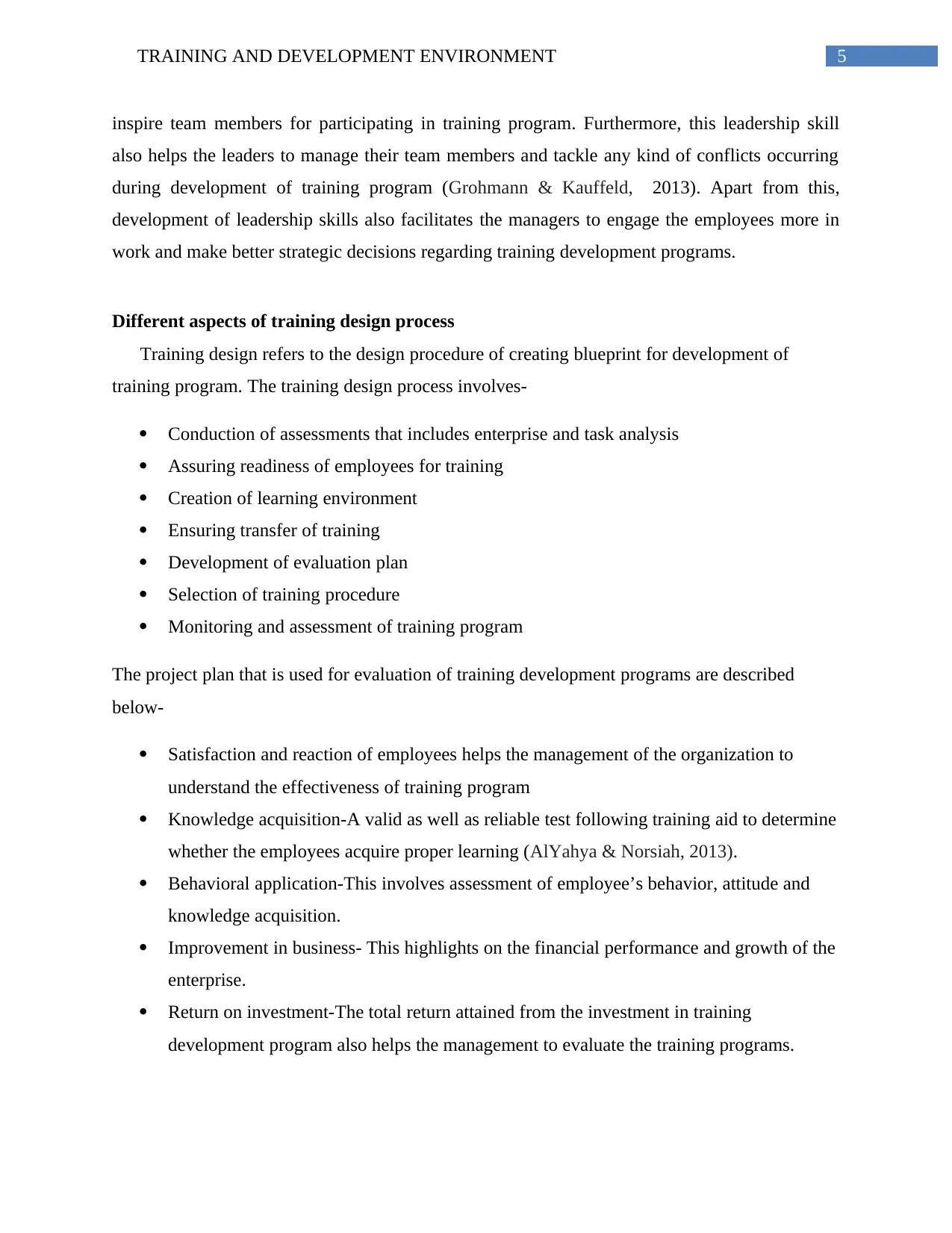
5TRAINING AND DEVELOPMENT ENVIRONMENT
inspire team members for participating in training program. Furthermore, this leadership skill
also helps the leaders to manage their team members and tackle any kind of conflicts occurring
during development of training program (Grohmann & Kauffeld, 2013). Apart from this,
development of leadership skills also facilitates the managers to engage the employees more in
work and make better strategic decisions regarding training development programs.
Different aspects of training design process
Training design refers to the design procedure of creating blueprint for development of
training program. The training design process involves-
Conduction of assessments that includes enterprise and task analysis
Assuring readiness of employees for training
Creation of learning environment
Ensuring transfer of training
Development of evaluation plan
Selection of training procedure
Monitoring and assessment of training program
The project plan that is used for evaluation of training development programs are described
below-
Satisfaction and reaction of employees helps the management of the organization to
understand the effectiveness of training program
Knowledge acquisition-A valid as well as reliable test following training aid to determine
whether the employees acquire proper learning (AlYahya & Norsiah, 2013).
Behavioral application-This involves assessment of employee’s behavior, attitude and
knowledge acquisition.
Improvement in business- This highlights on the financial performance and growth of the
enterprise.
Return on investment-The total return attained from the investment in training
development program also helps the management to evaluate the training programs.
inspire team members for participating in training program. Furthermore, this leadership skill
also helps the leaders to manage their team members and tackle any kind of conflicts occurring
during development of training program (Grohmann & Kauffeld, 2013). Apart from this,
development of leadership skills also facilitates the managers to engage the employees more in
work and make better strategic decisions regarding training development programs.
Different aspects of training design process
Training design refers to the design procedure of creating blueprint for development of
training program. The training design process involves-
Conduction of assessments that includes enterprise and task analysis
Assuring readiness of employees for training
Creation of learning environment
Ensuring transfer of training
Development of evaluation plan
Selection of training procedure
Monitoring and assessment of training program
The project plan that is used for evaluation of training development programs are described
below-
Satisfaction and reaction of employees helps the management of the organization to
understand the effectiveness of training program
Knowledge acquisition-A valid as well as reliable test following training aid to determine
whether the employees acquire proper learning (AlYahya & Norsiah, 2013).
Behavioral application-This involves assessment of employee’s behavior, attitude and
knowledge acquisition.
Improvement in business- This highlights on the financial performance and growth of the
enterprise.
Return on investment-The total return attained from the investment in training
development program also helps the management to evaluate the training programs.
⊘ This is a preview!⊘
Do you want full access?
Subscribe today to unlock all pages.

Trusted by 1+ million students worldwide
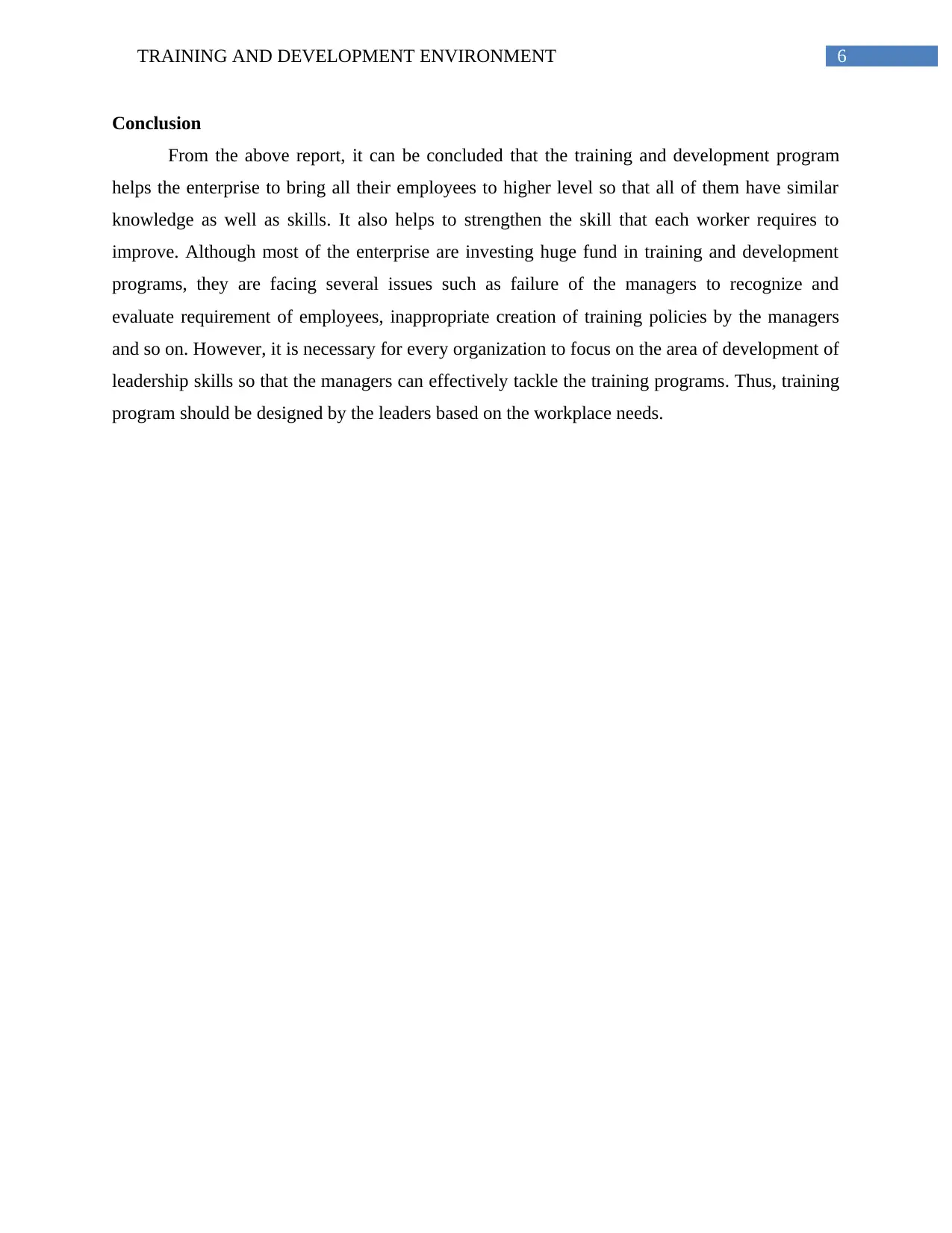
6TRAINING AND DEVELOPMENT ENVIRONMENT
Conclusion
From the above report, it can be concluded that the training and development program
helps the enterprise to bring all their employees to higher level so that all of them have similar
knowledge as well as skills. It also helps to strengthen the skill that each worker requires to
improve. Although most of the enterprise are investing huge fund in training and development
programs, they are facing several issues such as failure of the managers to recognize and
evaluate requirement of employees, inappropriate creation of training policies by the managers
and so on. However, it is necessary for every organization to focus on the area of development of
leadership skills so that the managers can effectively tackle the training programs. Thus, training
program should be designed by the leaders based on the workplace needs.
Conclusion
From the above report, it can be concluded that the training and development program
helps the enterprise to bring all their employees to higher level so that all of them have similar
knowledge as well as skills. It also helps to strengthen the skill that each worker requires to
improve. Although most of the enterprise are investing huge fund in training and development
programs, they are facing several issues such as failure of the managers to recognize and
evaluate requirement of employees, inappropriate creation of training policies by the managers
and so on. However, it is necessary for every organization to focus on the area of development of
leadership skills so that the managers can effectively tackle the training programs. Thus, training
program should be designed by the leaders based on the workplace needs.
Paraphrase This Document
Need a fresh take? Get an instant paraphrase of this document with our AI Paraphraser
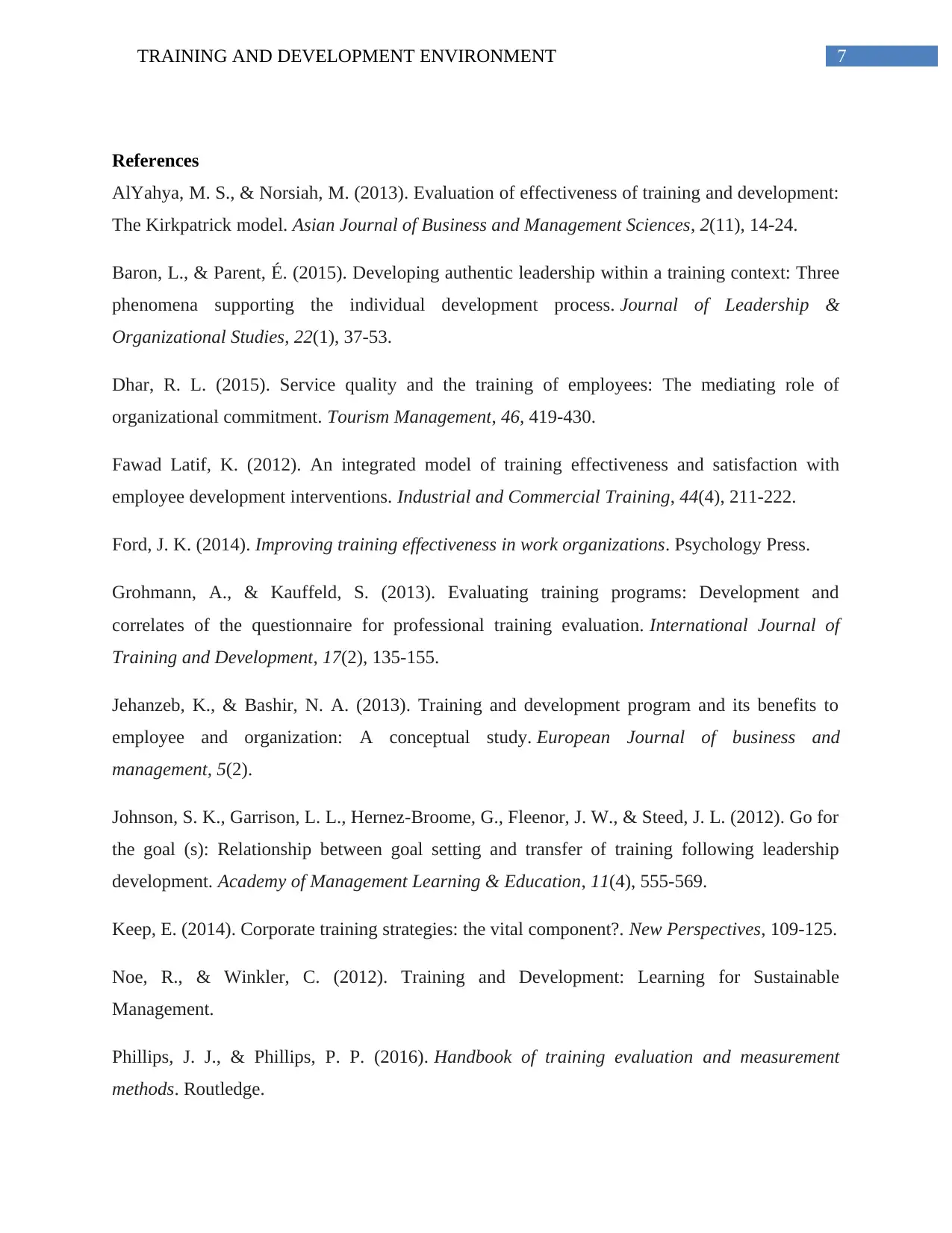
7TRAINING AND DEVELOPMENT ENVIRONMENT
References
AlYahya, M. S., & Norsiah, M. (2013). Evaluation of effectiveness of training and development:
The Kirkpatrick model. Asian Journal of Business and Management Sciences, 2(11), 14-24.
Baron, L., & Parent, É. (2015). Developing authentic leadership within a training context: Three
phenomena supporting the individual development process. Journal of Leadership &
Organizational Studies, 22(1), 37-53.
Dhar, R. L. (2015). Service quality and the training of employees: The mediating role of
organizational commitment. Tourism Management, 46, 419-430.
Fawad Latif, K. (2012). An integrated model of training effectiveness and satisfaction with
employee development interventions. Industrial and Commercial Training, 44(4), 211-222.
Ford, J. K. (2014). Improving training effectiveness in work organizations. Psychology Press.
Grohmann, A., & Kauffeld, S. (2013). Evaluating training programs: Development and
correlates of the questionnaire for professional training evaluation. International Journal of
Training and Development, 17(2), 135-155.
Jehanzeb, K., & Bashir, N. A. (2013). Training and development program and its benefits to
employee and organization: A conceptual study. European Journal of business and
management, 5(2).
Johnson, S. K., Garrison, L. L., Hernez-Broome, G., Fleenor, J. W., & Steed, J. L. (2012). Go for
the goal (s): Relationship between goal setting and transfer of training following leadership
development. Academy of Management Learning & Education, 11(4), 555-569.
Keep, E. (2014). Corporate training strategies: the vital component?. New Perspectives, 109-125.
Noe, R., & Winkler, C. (2012). Training and Development: Learning for Sustainable
Management.
Phillips, J. J., & Phillips, P. P. (2016). Handbook of training evaluation and measurement
methods. Routledge.
References
AlYahya, M. S., & Norsiah, M. (2013). Evaluation of effectiveness of training and development:
The Kirkpatrick model. Asian Journal of Business and Management Sciences, 2(11), 14-24.
Baron, L., & Parent, É. (2015). Developing authentic leadership within a training context: Three
phenomena supporting the individual development process. Journal of Leadership &
Organizational Studies, 22(1), 37-53.
Dhar, R. L. (2015). Service quality and the training of employees: The mediating role of
organizational commitment. Tourism Management, 46, 419-430.
Fawad Latif, K. (2012). An integrated model of training effectiveness and satisfaction with
employee development interventions. Industrial and Commercial Training, 44(4), 211-222.
Ford, J. K. (2014). Improving training effectiveness in work organizations. Psychology Press.
Grohmann, A., & Kauffeld, S. (2013). Evaluating training programs: Development and
correlates of the questionnaire for professional training evaluation. International Journal of
Training and Development, 17(2), 135-155.
Jehanzeb, K., & Bashir, N. A. (2013). Training and development program and its benefits to
employee and organization: A conceptual study. European Journal of business and
management, 5(2).
Johnson, S. K., Garrison, L. L., Hernez-Broome, G., Fleenor, J. W., & Steed, J. L. (2012). Go for
the goal (s): Relationship between goal setting and transfer of training following leadership
development. Academy of Management Learning & Education, 11(4), 555-569.
Keep, E. (2014). Corporate training strategies: the vital component?. New Perspectives, 109-125.
Noe, R., & Winkler, C. (2012). Training and Development: Learning for Sustainable
Management.
Phillips, J. J., & Phillips, P. P. (2016). Handbook of training evaluation and measurement
methods. Routledge.
1 out of 8
Related Documents
Your All-in-One AI-Powered Toolkit for Academic Success.
+13062052269
info@desklib.com
Available 24*7 on WhatsApp / Email
![[object Object]](/_next/static/media/star-bottom.7253800d.svg)
Unlock your academic potential
Copyright © 2020–2025 A2Z Services. All Rights Reserved. Developed and managed by ZUCOL.




